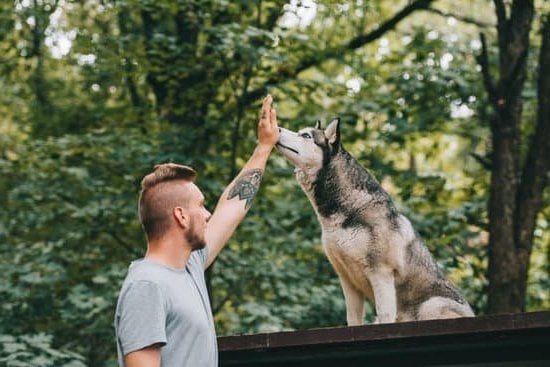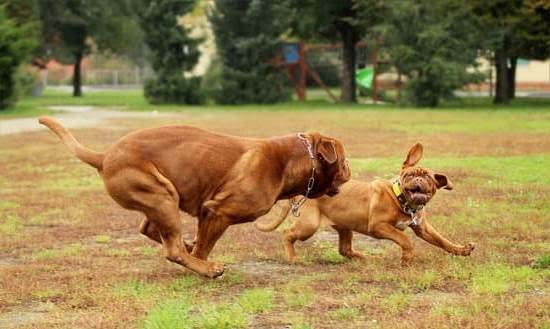Can big dogs be litter box trained? Many people believe that litter box training is only suitable for small dogs and cats, but there is a growing interest in exploring the possibility of litter box training for big dogs.
This article will delve into the basics, benefits, myths, and misconceptions surrounding litter box training for large breeds. Additionally, it will provide valuable insights into the factors to consider, step-by-step guides, tips and tricks, overcoming challenges, and real-life success stories of big dogs who have been successfully litter box trained.
Litter box training is commonly associated with small dog breeds or indoor cats, but many pet owners are curious about whether this method can also apply to larger canine companions. As more pet owners opt for apartment living or face challenges with outdoor potty solutions, understanding the potential of litter box training for big dogs becomes increasingly relevant.
By debunking myths and misconceptions and providing practical guidance, this article aims to offer valuable information for pet owners considering this alternative potty training method.
In the following sections, we will explore the fundamentals of litter box training and its benefits, as well as address common concerns related to size, breed, and age when it comes to implementing this approach with big dogs. From practical tips to real-life success stories, this comprehensive guide will equip pet owners with the knowledge needed to make an informed decision about litter box training for their big dogs.
Understanding Litter Box Training
Litter box training is a common method used to teach cats to use a designated spot for their bathroom needs. However, this technique can also be utilized for dogs, including big dogs. Litter box training involves teaching your canine companion to eliminate waste in a specific area, typically indoors. Understanding the basics of litter box training and its benefits can help pet owners decide if this method is suitable for their big dogs.
The Basics of Litter Box Training
Litter box training involves introducing your dog to a designated area where they are encouraged to eliminate waste. This spot can be an actual litter box, puppy pad, or even a patch of fake grass. The key is to establish consistency and provide positive reinforcement when your dog uses the designated area.
The Benefits of Litter Box Training
One of the main benefits of litter box training for big dogs is convenience. This method allows pet owners who live in apartments or have limited outdoor space to provide their dogs with a designated spot for bathroom needs. Additionally, it can be beneficial for elderly or disabled individuals who may find it challenging to take their large dogs outside multiple times a day.
By understanding the basics of litter box training and its benefits, pet owners can make an informed decision about whether this method is suitable for their big dogs. It’s important to consider various factors such as size, breed, and age before embarking on the journey of litter box training.
Can Big Dogs Really Be Litter Box Trained? Debunking Myths and Misconceptions
There are several common myths and misconceptions surrounding the idea of litter box training big dogs. One of the most prevalent misconceptions is that only small dogs or cats can be litter box trained, while big dogs are too difficult to train in this manner. However, the truth is that with the right approach and commitment, many big dogs can indeed be successfully litter box trained.
Another myth is that litter box training a big dog will lead to an increase in indoor accidents and make it more difficult for them to transition back to outdoor elimination. In reality, proper litter box training can actually decrease indoor accidents and provide a consistent elimination spot for your big dog, especially in situations where they cannot go outside due to weather or health reasons.
It’s also commonly believed that only certain breeds of big dogs can be litter box trained. While it’s true that some breeds may require more patience and effort than others, there is no specific breed limitation when it comes to litter box training. With the right techniques and a good understanding of your dog’s behavior and needs, almost any big dog can learn to use a litter box effectively.
Factors to Consider
When considering litter box training for big dogs, it’s important to take into account their size, breed, and age. These factors can significantly impact the success of the training and determine whether or not it is a feasible option for your pet. Understanding how these elements come into play will help you make an informed decision about whether litter box training is suitable for your big dog.
Size
The size of your big dog is a crucial factor to consider when contemplating litter box training. Larger breeds will naturally produce more waste, requiring a larger and more durable litter box. Additionally, the physical ability of your dog to comfortably use the litter box without causing messes or discomfort is essential. It’s important to ensure that the litter box is appropriately sized for your big dog to encourage successful training.
Breed
Different dog breeds have varying temperaments and tendencies when it comes to bathroom habits. Some breeds may be more receptive to litter box training due to their natural instincts, while others may find it challenging to adapt. Researching the specific characteristics and behaviors of your dog’s breed can provide valuable insight into whether they are well-suited for this type of training.
Age
The age of your big dog is another important consideration for litter box training. Puppies may be more adaptable and open to learning new behaviors, making them ideal candidates for this type of training. On the other hand, older dogs may have established bathroom habits that are more difficult to change. Considering your dog’s age can help set realistic expectations for the success and timeline of litter box training efforts.
By taking these factors into account, you can assess whether litter box training is a viable option for your big dog. While each dog is unique, understanding how size, breed, and age influence their potential for success in this type of training will guide you in making the best decision for your furry companion.
The Step-by-Step Guide
Litter box training a big dog may seem like a daunting task, but with the right approach and consistency, it is indeed possible. The first step in this process is choosing the right type of litter box for your big dog. For larger breeds, it’s essential to select a spacious and sturdy box that can accommodate their size. Some owners opt for DIY options, such as using kiddie pools or even converting plastic storage containers into litter boxes.
Once you have the appropriate litter box, it’s time to introduce your big dog to the concept. Start by placing the litter box in a designated area where your dog feels comfortable and at ease. Encourage them to explore the box and become familiar with it. It’s important to praise and reward your dog for showing any interest in the litter box, as positive reinforcement plays a crucial role in this training process.
After your big dog has become accustomed to the presence of the litter box, you can begin guiding them towards using it for elimination. This involves closely monitoring your dog’s behavior and body language for signs that they need to relieve themselves.
When you notice these cues, gently lead your dog to the litter box and encourage them to do their business there. It’s important to stay patient and consistent throughout this training period, as big dogs may take longer to adapt to this new routine.
| Aspect | Description |
|---|---|
| Litter Box Type | Spacious and sturdy for large breeds; DIY options like kiddie pools or converted storage containers |
| Introducing the Litter Box | Place in a designated area; encourage exploration; use positive reinforcement for interest |
| Guiding Towards Use | Monitor behavior for elimination cues; gently lead to litter box; stay patient and consistent |
Tips and Tricks for Successful Litter Box Training
Litter box training a big dog can be a challenging task, but with patience, consistency, and positive reinforcement, it is definitely achievable. Here are some tips and tricks for successful litter box training for big dogs:
- Patience is key: Litter box training takes time and each dog learns at their own pace. It’s important to remain patient and not get frustrated if there are setbacks along the way.
- Consistency is crucial: Establishing a routine is essential in litter box training. Take your dog to the litter box at the same times every day, especially after meals and before bedtime.
- Positive reinforcement: Use treats, praise, and rewards to encourage your big dog to use the litter box. When they do eliminate in the appropriate spot, make sure to show them how pleased you are.
Additionally, it’s essential to keep the litter box clean at all times. Big dogs may be more sensitive to odors and cleanliness than smaller dogs, so keeping their designated bathroom area tidy will encourage them to continue using it. Lastly, never punish your dog for accidents outside of the designated area. Negative reinforcement can lead to anxiety and fear in your pet, making it even more difficult for them to learn proper elimination habits.
Overcoming Challenges
Litter box training big dogs can pose its own set of challenges. One common issue is the size of the litter box itself. Larger dogs require bigger boxes, and finding one that is suitable for their size can sometimes be difficult. Another challenge is getting the dog to actually use the litter box, especially if they are used to going outside. This can take time and patience to train them to associate the litter box with going to the bathroom.
One solution to the size issue is to use a plastic storage container as a makeshift litter box. These containers are spacious enough for larger dogs and come in various sizes to accommodate different breeds. Another solution is using positive reinforcement such as treats or praise when the dog uses the litter box correctly. This helps to create a positive association with the behavior, making them more likely to continue using it.
It’s also important for pet owners to be prepared for accidents during the training process. Accidents are bound to happen, so having cleaning supplies on hand is essential for keeping your home clean during this transition period.
| Challenges | Solutions |
|---|---|
| Size of litter box | Use plastic storage container |
| Dog not using litter box | Positive reinforcement (treats or praise) |
| Accidents during training | Have cleaning supplies on hand |
Real-Life Success Stories
Litter box training big dogs may seem like a daunting task, but there are actually many success stories of pet owners who have successfully trained their large breed dogs to use a litter box. One such success story is that of Max, a 90-pound Labrador Retriever who lives in an apartment with his owner. With patience, consistency, and positive reinforcement, Max’s owner was able to successfully train him to use a litter box indoors.
Another inspiring success story is that of Bella, a Great Dane who had health issues that made it difficult for her to go outside frequently. Her owner decided to try litter box training as an alternative solution, and after some initial challenges, Bella successfully learned to use the litter box indoors. These real-life success stories demonstrate that with the right approach and dedication, even big dogs can be litter box trained.
These success stories also serve as a reminder that each dog is unique and may require different approaches to litter box training. What works for one dog may not work for another, so it’s important for pet owners to be patient and flexible in their training methods. By understanding the specific needs and behaviors of their big dogs, pet owners can increase the likelihood of successful litter box training.
Conclusion
In conclusion, while the idea of litter box training big dogs may seem unconventional, it is indeed possible with the right approach and dedication. Understanding the basics and benefits of litter box training, debunking myths and misconceptions, considering factors such as size, breed, and age, following a step-by-step guide, and implementing tips and tricks for successful training are all essential in making an informed decision.
It is important to remember that patience, consistency, and positive reinforcement play a crucial role in the success of litter box training for big dogs.
As with any training process, there will be challenges along the way. However, by being prepared to overcome common issues and seeking solutions to specific problems that may arise during the training process, big dog owners can increase their chances of success. Real-life success stories of big dogs who have been litter box trained serve as inspiration and proof that with dedication and effort, it is possible to train even large breeds to use a litter box.
Ultimately, whether or not to litter box train a big dog is a personal decision that should take into consideration the needs of both the dog and its owner. By weighing the pros and cons and understanding the commitment involved in such training, individuals can make a well-informed decision that is best suited for their particular circumstances. With the right approach, patience, and perseverance, litter box training can offer practical benefits for both big dogs and their owners.
Frequently Asked Questions
Can You Train a Large Dog to Use a Litter Box?
Training a large dog to use a litter box is possible, but it may require more effort and patience compared to training a small dog. It’s important to choose the right size litter box for your large dog and use positive reinforcement techniques during the training process.
Consistency and praise for success are key elements in successfully teaching a large dog to use a litter box.
Can You Litter Box Train an Older Dog?
While it may be more challenging to litter box train an older dog, it is definitely possible with patience and consistency. Older dogs may have established habits that need to be unlearned, so the training process may take longer than with a puppy.
It’s important to be understanding of any setbacks and maintain a consistent training routine to help an older dog successfully adapt to using a litter box.
How Do You Make a Large Dog Litter Box?
Making a large dog litter box can be as simple as using a plastic storage container or purchasing a commercial extra-large litter box designed for big breeds. The key is ensuring that the litter box is spacious enough for the dog to comfortably move around in.
Additionally, placing the right type of litter and keeping the area clean are essential for encouraging the dog to use the designated spot consistently. Providing easy access to the litter box is also important, especially for larger breeds.

Welcome to the blog! I am a professional dog trainer and have been working with dogs for many years. In this blog, I will be discussing various topics related to dog training, including tips, tricks, and advice. I hope you find this information helpful and informative. Thanks for reading!





